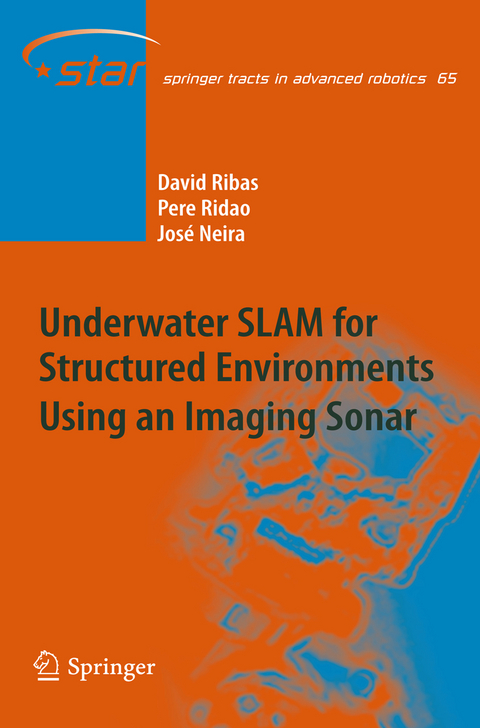
Underwater SLAM for Structured Environments Using an Imaging Sonar
Springer Berlin (Verlag)
978-3-662-50658-5 (ISBN)
Robotics is undergoing a major transformation in scope and dimension. From a largely dominant industrial focus, robotics is rapidly expanding into human en- ronments and vigorously engaged in its new challenges. Interacting with, assisting, serving, and exploring with humans, the emerging robots will increasingly touch people and their lives. Beyond its impact on physical robots, the body of knowledge robotics has p- duced is revealing a much wider range of applications reaching across diverse research areas and scienti?c disciplines, such as: biomechanics, haptics, neu- sciences, virtual simulation, animation, surgery, and sensor networks among others. In return, the challenges of the new emerging areas are proving an abundant source of stimulation and insights for the ?eld of robotics. It is indeed at the intersection of disciplines that the most striking advances happen. The SpringerTracts in AdvancedRobotics(STAR) is devoted to bringing to the research community the latest advancesin the robotics ?eld on the basis of their signi?cance and quality. Through a wide and timely dissemination of critical - search developments in robotics, our objective with this series is to promote more exchanges and collaborations among the researchers in the community and c- tribute to further advancements in this rapidly growing ?eld.
David Ribas was born in Girona, Spain, in 1978. He received the M.S. degree in Industrial Engineering from the University of Girona, Spain, in 2003 and the Ph. D. degree in industrial engineering from the same university, in 2008. At the present time, he is a researcher in the Underwater Robotics Laboratory at the Computer Vision and Robotics Group from the University of Girona. His research activity is mainly focused on underwater robotics in the fields of sensor fusion, vehicle localization and map building. Pere Ridao was born in Spain in 1969. He received the Ms.C. degree in computer science in 1993 from the Technical University of Catalonia, Barcelona, Spain, and the Ph.D. degree in computer engineering in 2001 from the University of Girona, Spain. His research activity is mainly focused on underwater robotics in research topics such as intelligent control architectures, UUV modelling and identification, simulation, Navigation, Mission Control and real-time systems. He joined the Institute of Informatics and Applications, University of Girona, in September 1995. Currently, he is an associate professor with the Department of Computer Engineering of the University of Girona and the head of the Research Center in Underwater Robotics (CIRS) located in the Scientific and Technological Park of the University of Girona. He is involved in national projects and European research networks about underwater robotics and some technology transference projects about real-time and embedded systems. Dr. Ridao is member of the IFAC's Technical Committee on Marine Systems, member of the editorial board of Springer's Intelligent Service Robotics journal, secretary of the Spanish OES chapter and also a board member of the Spanish RAS chapter. José Neira was born in Bogotá, Colombia, in 1963. He received the M.S. degree in computer science from the Universidad de los Andes, Colombia, in 1986, and the Ph.D. degree in computer science from the University of Zaragoza, Spain, in 1993. He is Associate Professor in the Departamento de Informática e Ingeniería de Sistemas, University of Zaragoza, where he is in charge of courses in compiler theory, computer vision and mobile robotics. His current research interests include autonomous robotics and environment modelling. José has been guest editor of the IEEE Transactions on Robotics special issue on Visual SLAM, together with Andrew Davison, Imperial College London, and John Leonard, MIT. He is currently associate editor of the IEEE Transactions on Robotics, guest editor of Autonomous Robots for the special issue on RSS 2008, together with Jeff Trinkle, Rensselaer Polytechnic Institute, and guest editor of Robotics and Autonomous Systems for the special issue Inside Data Association, together with Udo Frese, University of Bremen. He is also area chair for the Robotics: Science and Systems 2009 conference and local arrangements chair for Robotics: Science and Systems 2010.
State of the Art.- Design and Development of the Ictineu AUV.- Understanding Mechanically Scanned Imaging Sonars.- Localization with an a priori Map.- Simultaneous Localization and Mapping.- Conclusion.
| Erscheinungsdatum | 16.07.2016 |
|---|---|
| Reihe/Serie | Springer Tracts in Advanced Robotics |
| Zusatzinfo | XX, 144 p. |
| Verlagsort | Berlin |
| Sprache | englisch |
| Maße | 155 x 235 mm |
| Gewicht | 261 g |
| Themenwelt | Informatik ► Theorie / Studium ► Künstliche Intelligenz / Robotik |
| Technik ► Elektrotechnik / Energietechnik | |
| Technik ► Maschinenbau | |
| Schlagworte | autonom • Knowledge • Localization • Navigation • Sensor Fusion • SLAM • Sonar • Underwater Robotics |
| ISBN-10 | 3-662-50658-0 / 3662506580 |
| ISBN-13 | 978-3-662-50658-5 / 9783662506585 |
| Zustand | Neuware |
| Haben Sie eine Frage zum Produkt? |
aus dem Bereich


